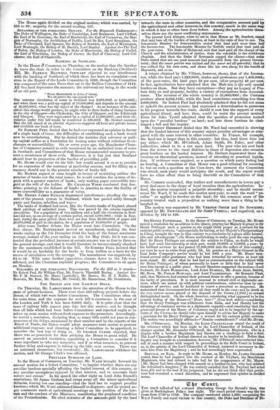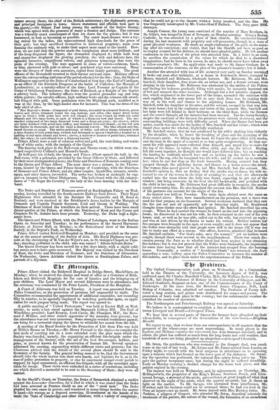Cbt (court.
THE much talked-of bal costume illustrating George the Second's time, was given at Buckingham Palace last night. The exact period chosen was the ten ran from 1740 to 1750. The company numbered about 1,2001 comprising the Royal Family and royal visitors to this country, the Duke and Dutchess of Ne- minus among them; the chief of the British aristocracy; the diplomatic persons, and principal foreigners in town. Grave statesmen and officials took part in the gayety,—Sir Robert Peel being among the earliest of the festive throng; which was spiced with the presence of many a Senator and Judge. The costume was a tolerably exact counterpart of that set down for the guests; but it was humoured, to look as becoming as possible. The outré head-dresses were a try- ing ordeal for the ladies, the unaccustomed high shoe-heels for the grace of their gait: but they sacrificed themselves to historical propriety; some even denning the untimely wig, to make their aspect more exact to the modeL How- ever, we are told that the powder made the complexion show more brilliant; and if the hoop disguised the figure, the stomacher displayed it; while both hoop and stomacher displayed the glowing jewellery, the rich and delicate lace, the splendid brocades, magnificent velvets, and gorgeous trimmings that were the pride of the evening. The men appeared in coats of velvet—crimson, black, or blue, plastered with gold or silver; and powdered wigs were universal. Many wore the dresses of their own ancestors, copied from family portraits. The great officers of the Household reverted to their former outward state. Military officers wore the corresponding uniforms of the period selected for the fete: thus, the Duke of Wellington appeared as the Duke of Cumberland of that day; the Earl of Cardigan, as an officer of the Eleventh Dragoons at the battle of Culloden; the Marquis of Londonderry, as a cavalr.y-officer of the time; Lord Forester as Captain of the Corps of Gentlemen Pensioners; the Dake of Rutland, as a Knight of the Garter ¢ury back. The infantry-officers wore the peaked grenadier cap and long white gaiters; the cavalry-officers, high military boots and the crimson silk sword- helt fringed with gold. Some gentlemen wore the Highland garb, modified as it was at the time, by the high-heeled shoe for instance. This was the dress of the lady chief of all- " Her Majesty's Drees.—Composed of gold tissue, brocaded in coloured flowers, green leaves and silver, trimmed round the top, bottom, and sides, (the upper dress being open in front,) with point lace over red riband ; the dress looped up with red satin rlbands and two large bows, in each of which is a diamond bow and tassel. The go- Macher composed of two large diamond bows and a diamond point ; the sleeves, which are tight, finished with point-lace ruffles, and trimmed with red riband ; on the left arm the Garter in diamonds, and on the right a diamond rosette. The blue riband and dia- mond George as usual. The under-petticoat, of white and silver tissue, trimmed with a deep flounce of rich point-lace, (which had belonged to Queen Charlotte,) headed by a quilling of red satin riband and bows ; above, a narrower flounce of point-lace, trimmed Like the other ; in each riband-bow a diamond rosette."
Prince Albert wore a suit of crimson velvet and gold, the coat-lining and waist- coat of white satin; with the insignia of the Garter.
The dancing took placein the Ball-room and Throne-room; in which were sta- tioned respectively Collinet's and Musard's bands.
At half-past ten o'clock; the Queen and Prince Albert opened the ball, in the Ball-room, with a polonaise, preceded by the Great Officers of State, and followed by their most distinguished guests; the Duke and Dutchess of Nemours coming next to the Queen and Prince Albert. The next dance was a minuet, in the Throne- room, headed by the Queen and Prince George of Cambridge, with the Dutchess of Nemours and Prince Albert, and six other couples. Quadrilles, minuets, strath- speys, and other dances, succeeded. The series was broken at midnight by sup- per—a banquet in the Great Diningroom. The ball closed with the old country- dance of "Sir Roger De Coverley"; the lady of the feast dancing with her hus- band.
The Dake and Dutchess of Nemours arrived at Buckingham Palace on Wed- nesday, having travelled by the South-eastern Railway from Dover. Their Royal Highnesses were attended by the Baronne De Fruguerlin and M. Borel de Bretizel; and were received at the Bricklayer's Arms station by the Marquis of Ormonde and Captain Francis Seymour, Lord and Grooni in Waitine.. The Diatchess of Kent visited the travellers on their arrival. There have been small dinner-parties at the Palace, at which the Dute,hess of Kent and the Count and Countess De St. Anlaire have been present. Yesterday, the Duke held a diplo- matic levee.
• The Queen and Prince Albert, with the Prince of Leiningen, went to the Italian Opera on Saturday and Tuesday; to the performance of the Sacred Harmonic Society,, at Exeter Hall, on Monday; to the floricultural show of the Botanic Society, in the Regent's Park, on Wednesday.
Prince Albert visited Bridewell Hospital on Monday; and presided on the same day at the annual meeting of the Society of Arts. His Royal Highness was pre- sent at the christening of M.Van der Weyer's son, in St. George's ChapeLon Tues- day; standing godfather to the child, who was mimed " Albert-Sylvan-Bates." The Queen Dowager has been unwell for a few days lately, with a slight cold; but seems now to have quite recovered. Her Majesty was visited by the Dutchess of Kent, the Duke and Dntehess of Nemours, and the Dutchess of Gloucester. On Wednesday Queen Adelaide visited the Queen at Bnekingham Palace, and partook of a.dejenner.



























 Previous page
Previous page